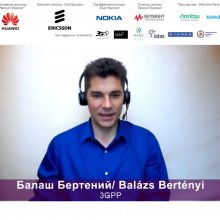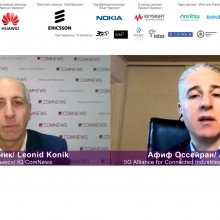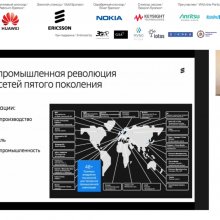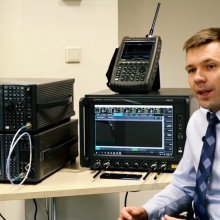About the event
Wireless Russia & CIS 2020: All Nationalities Welcome In Spitе Of The Pandemic
The 12th International Business Forum “Wireless Russia & CIS: LTE, 5G and IoT – New Technologies, Business Models and Effective Use of Spectrum” was held on November 19-20, 2020. Due to the COVID-10 pandemic, the event took place online. However, Wireless Russia & CIS 2020 had one of the highest profile panel of experts in the 12-year history of the forum in terms of international participation.
The two-day event gathered 354 specialists from Russian and foreign communication service and IoT providers, developers of digital solutions, regulators, major industry associations, analysts and the media.
The Forum was supported by a lineup of stellar 5G players: Platinum Sponsor of Wireless Russia & CIS 2020 was Huawei, Golden Sponsor was Ericsson, and Silver Sponsor was Nokia. Keysight Technologies was Session Sponsor. Also, Anritsu and Iskra UralTel supported the Forum. Besides, it was endorsed by high-profile global partnerships and associations - 3GPP, GSA, MVNO Europe, along with Russian IoT Association, Autonomous Non-Commercial Organization “Digital Economy”, The IT&Digital Directors’ Club, International Academy of Comяmunications.
Almost every session of the forum featured a renowned international expert, including 3GPP’s Chairman of Technical Specification Group for Radio Access Network (TSG RAN) Balázs Bertényi, Chairman of ITU-R’s Task Group 6/1 and Vice-Chairman of WRC-23 Preparatory Meeting Sergey Pastukh; President of Global mobile Suppliers Association (GSA) Joe Barret; Chief Executive Officer of The Next Generation Mobile Networks (NGMN) Alliance Anita Döhler; Technical Officer of the European Telecommunications Standards Institute (ETSI) Igor Minaev; CEO and Chairman of global MVNO operator Transatel S.A. (France) and President of MVNO Europe Association Jacques Bonifay; General Vice-Chair of the 5G Alliance for Connected Industries and Automation (5G-ACIA) Afif Osseiran.
Wireless Russia & CIS 2020 became the first public event, where Rashid Ismailov spoke in his new role of the President of VimpelCom. The forum was also the first ever event where domestic 5G base stations from Sozvezdie Concern made an appearance. A corresponding presentation was delivered by Head of the Leading Innovation Center (LIC) "Global Wireless Technologies" and Director of Scientific and Technical Center for Advanced Development GlobalInformService (Concern Sozvezdie) Vadim Belyavskiy. Another speaker, who also looked into the subject of domestic 5G equipment was Vitaliy Shub, Skoltech’s Head of Leading Research Center.
On the first day of Wireless Russia & CIS 2020, the Executive Committee for Digital Development chaired by Deputy Prime Minister Dmitriy Chernyshenko approved a roadmap for 5G in Russia. It will be supervised by State Corporation Rostec that will develop domestic equipment for the new generation networks, and Rostelecom, that will roll out the network and implement digital services based on 5G. According to the roadmap, by 2024 Rostec will have received 21.463 billion rubles from the federal project “Digital Technologies” to fund manufacturing of Russian-made base stations. A budget of 7.393 billion rubles was allocated for spectrum conversion within the federal project “IT infrastructure”, compared with the previous plan that envisaged an investment of about 40 billion rubles in order to make spectrum available for 5G services.
“Besides, we have three major issues: frequency bands haven’t been allocated yet, the equipment has to be domestic, and there appears to be no end to the talks between telecommunication service providers and the government,” Roman Yakovlev, Head of “The Information Infrastructure” Division, Digital Economy ANCO, said at Wireless Russia & CIS 2020. He assumes that the 4.8-4.99 GHz band will be cleared for the new generation networks, but according to Yakovlev, it won’t be enough, the four operators will need at least twice the spectrum to meet their needs.
VimpelCom’s Director of Regulatory Affairs Konstantin Zudin is convinced that the 4.8-4.99 GHz band could not be an alternative for 3.4-3.8 GHz. “To begin with, at this point the 4.8-4.99 band still doesn’t count with a complete eco-system of base and subscriber equipment. Secondly, there are difficulties with international coordination: 300km onshore and 450km offshore areas, where there would be the need to coordinate the use of the frequencies with our neighboring countries,” Zudin said at the plenary discussion. “Thirdly, in Europe, 4.8-4.99 GHz is used by air services, which could make coordination in border regions really difficult.”
One of the sessions that sparked increased interest in the audience was the session entitled “LTE and 5G networks for corporations (Private LTE & 5G)”, which kicked off the second day of the forum. The first speaker of the session was Afif Osseiran, head of the global association 5G-ACIA, which gathers industrial corporations, vendors of equipment and mobile operators, so that the three parties can join forces and develop successful scenarios for private 5G networks and mutually fruitful collaborations. And all these three stakeholders in the new ecosystem of corporate (private) networks had a representative in this session. The perspective of an industrial company was covered by Head of Customer Support Department, Gazpromneft Information Technological Operator (Gazpromneft ITO) Pavel Martynov and SIBUR’s Head of Telecommunications Practice Igor Tucha. Vendors were represented by speakers from Huawei, Ericsson, Nokia and IskraUralTEL. Finally, Pavel Bakhteyarov, Private Networks Sales Group Leader from MTS, spoke on behalf of the operator community.
Thus, Igor Tucha pointed out that no big industrial corporation would ever trust their technological traffic to commercial service providers, therefore allocating spectrum for private companies’ needs is absolutely justified in his opinion. He added that the subject matter is being discussed on the level of the federal ministries of energy and digital development (and one of the bands under debate is 3.8-3.99 GHz). In contrast, Pavel Martynov emphasized that a corporation needs a mobile network not only for its internal needs, but also to contact third-party suppliers and contractors, and therefore, it couldn’t be isolated (i.e. it needs to have access to public networks and roaming services). Representatives of Gazpromneft and SIBUR agreed that Russian industrial customers would undoubtedly do business with mobile operators, at least on the network deployment stage. Further discussion revealed that managed services model, actively promoted by vendors, is nearly inapplicable for the industrial sector. This business model can work when the vendor offers outsourcing services to at least two different mobile networks on the same territory. However, when it comes to corporate network, it is very unlikely that two different business organizations would have their industrial assets in exactly the same area.
Two special technology-focused sessions of Wireless Russia & CUS 2020 that were organized as panel discussions, were very compelling in terms of both speakers and content. The sessions were entitled “New business models for MVNO: Virtual operators in the age of IoT and 5G networks” and “IoT: Underway towards a billion of connected devices”. The latter session, which concluded the whole event, offered an overview of views and opinions from representatives of all major IoT technologies – from domestic (STRIJ and WAVIoT) to LoRaWAN, Sigfox and NB-IoT. In conclusion, Chairman of the IoT Market Association Andrey Kolesnikov commented that the IoT market directly depends on the economy, so an explosive growth is not to be expected in 2021. “All we can see next year is an increase in connected devices,” said Andrey Kolesnikov. “The market won’t grow with revenues, it will actually shrink, same as our economy in general. Dated equipment will be replaced, it is a natural process, but we are not talking about a snowballing growth. Clouds will grow more or less. Transport telematics will also see organic growth, but nothing explosive. 5G won’t be happening until 2025. I believe that automation market can grow by 4-5% at best in monetary terms. It will grow by enhancing the efficiency of business and cutting costs.”
Wireless Russia & CIS 2021 will be held on May 27-28, regardless of the epidemiologic situation. Whether it will be physical or phygital is yet to be confirmed.







